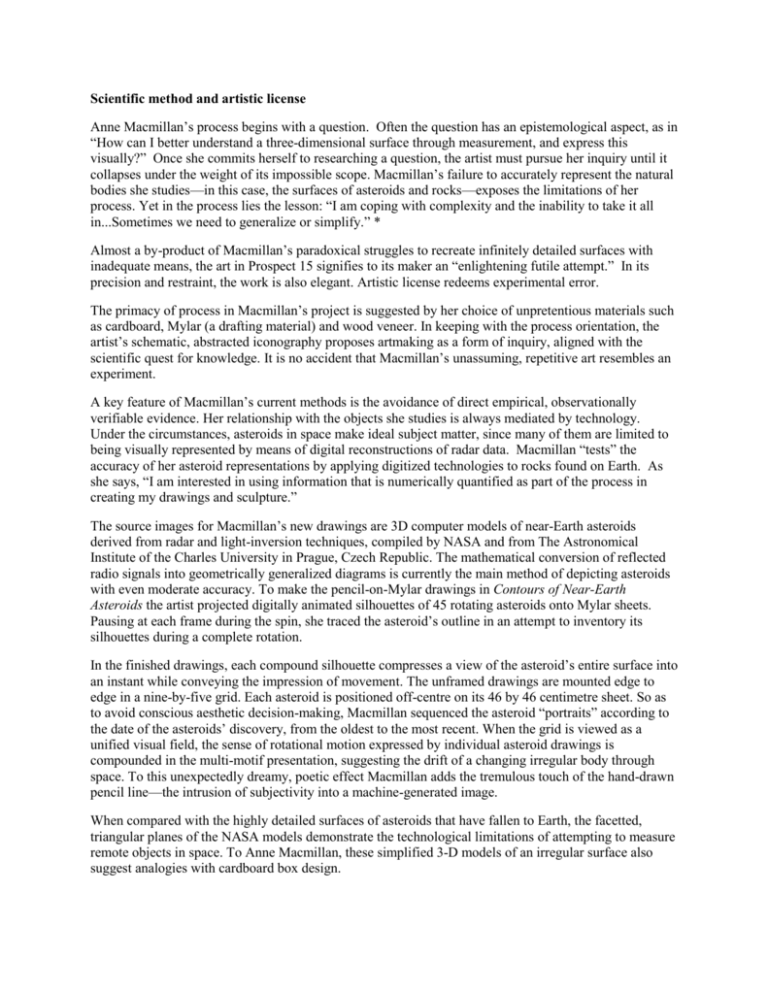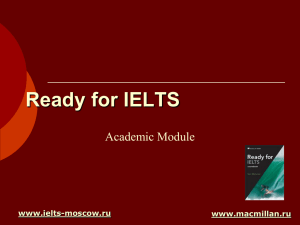Ingrid Jenkner -Scientific method and artistic license
advertisement

Scientific method and artistic license Anne Macmillan’s process begins with a question. Often the question has an epistemological aspect, as in “How can I better understand a three-dimensional surface through measurement, and express this visually?” Once she commits herself to researching a question, the artist must pursue her inquiry until it collapses under the weight of its impossible scope. Macmillan’s failure to accurately represent the natural bodies she studies—in this case, the surfaces of asteroids and rocks—exposes the limitations of her process. Yet in the process lies the lesson: “I am coping with complexity and the inability to take it all in...Sometimes we need to generalize or simplify.” * Almost a by-product of Macmillan’s paradoxical struggles to recreate infinitely detailed surfaces with inadequate means, the art in Prospect 15 signifies to its maker an “enlightening futile attempt.” In its precision and restraint, the work is also elegant. Artistic license redeems experimental error. The primacy of process in Macmillan’s project is suggested by her choice of unpretentious materials such as cardboard, Mylar (a drafting material) and wood veneer. In keeping with the process orientation, the artist’s schematic, abstracted iconography proposes artmaking as a form of inquiry, aligned with the scientific quest for knowledge. It is no accident that Macmillan’s unassuming, repetitive art resembles an experiment. A key feature of Macmillan’s current methods is the avoidance of direct empirical, observationally verifiable evidence. Her relationship with the objects she studies is always mediated by technology. Under the circumstances, asteroids in space make ideal subject matter, since many of them are limited to being visually represented by means of digital reconstructions of radar data. Macmillan “tests” the accuracy of her asteroid representations by applying digitized technologies to rocks found on Earth. As she says, “I am interested in using information that is numerically quantified as part of the process in creating my drawings and sculpture.” The source images for Macmillan’s new drawings are 3D computer models of near-Earth asteroids derived from radar and light-inversion techniques, compiled by NASA and from The Astronomical Institute of the Charles University in Prague, Czech Republic. The mathematical conversion of reflected radio signals into geometrically generalized diagrams is currently the main method of depicting asteroids with even moderate accuracy. To make the pencil-on-Mylar drawings in Contours of Near-Earth Asteroids the artist projected digitally animated silhouettes of 45 rotating asteroids onto Mylar sheets. Pausing at each frame during the spin, she traced the asteroid’s outline in an attempt to inventory its silhouettes during a complete rotation. In the finished drawings, each compound silhouette compresses a view of the asteroid’s entire surface into an instant while conveying the impression of movement. The unframed drawings are mounted edge to edge in a nine-by-five grid. Each asteroid is positioned off-centre on its 46 by 46 centimetre sheet. So as to avoid conscious aesthetic decision-making, Macmillan sequenced the asteroid “portraits” according to the date of the asteroids’ discovery, from the oldest to the most recent. When the grid is viewed as a unified visual field, the sense of rotational motion expressed by individual asteroid drawings is compounded in the multi-motif presentation, suggesting the drift of a changing irregular body through space. To this unexpectedly dreamy, poetic effect Macmillan adds the tremulous touch of the hand-drawn pencil line—the intrusion of subjectivity into a machine-generated image. When compared with the highly detailed surfaces of asteroids that have fallen to Earth, the facetted, triangular planes of the NASA models demonstrate the technological limitations of attempting to measure remote objects in space. To Anne Macmillan, these simplified 3-D models of an irregular surface also suggest analogies with cardboard box design. In contrast with the standard cube-form, six-sided box, which is machine-cut and scored, Macmillan proposes a box form more analogous, or more tailored, to its contents. Her Box for Hypothetical Asteroid, for example, has thousands of sides. It is designed to encapsulate an imaginary asteroid modeled by the artist. Partially flattened and mounted on the wall, the laser-cut and scored birch-veneer “box” (the technical term for such flat, topographical schema is “net”) measures about fifteen by nine feet. The asteroid it is designed to enclose would be very small. Macmillan jokes that in modelling this hypothetical object, she is playing God. Because of its generic shape and the sheer number of asteroids, the statistical probability of such an asteroid’s existence is high. Theoretically, the net could be folded into the three-dimensional shape of an asteroid. Presenting it in flattened form, as with the asteroid contour drawings, enables an instantaneous view of the complete surface. As a complex, irregular shape composed of variously shaped triangles, Box for a Hypothetical Asteroid is already interesting visually. To convey its potential for describing volume, however, Macmillan presents it in partial relief, with some of its facets folded and projecting forward. The decisions about which areas to fold have nothing to do with the subject matter, of course. Instead, Macmillan’s manipulation of the surface exploits the subtle reflective qualities of the wood, generating patterns of light and shadow that prompt comparison with the monochromatic faceting of Analytical Cubist painting. The aims of Cubist paintersto describe objects simultaneously in space and in timewere not so different from those of Anne Macmillan. In keeping with the principle of one-to-one scale exemplified in Box for Hypothetical Asteroid, the next step for Macmillan was to collect small rocks, subject them to 3-D scanning, and generate laser-cut and scored “nets” in which to enshroud them. The 44 Boxes for Rocks are composed of intricately scored cardboard nets wrapped around actual stones. The wrapped-rock sculptures appear in the sequence of their discovery on industrial shelving. The process of wrapping each rock by hand was time consuming and labour intensive. Often the rock had to be rescanned or the designs adjusted to fit properly. There were many discards. Significantly, gaps in the cardboard design signal failures in the software’s ability to unfold a complex shape. The artist had knowingly set herself an impossible task. At the centre of Macmillan’s project is the problem of representing visually the surface topography of irregular three-dimensional objects, using a limited set of technologies and a restricted range of artmaking techniques. Macmillan’s intermedia practice reconciles artisanal processes, such as drawing and handforming, with technological processes such as digital animation, 3-D modeling, 3-D scanning and laser cutting. Her process balances strict rules, quantification and machine-generated imagery with the accidents entailed by hand-crafting and intuitive decision-making. The elaborate problems set by the artist for herself are ultimately pretexts for generating artistic output. Because of its internal contradictions, her art transcends its rationale; the contest between its denotative and connotative components will never be settled, and we must content ourselves with a finding of absurdity. Ingrid Jenkner Curator *Quotations come from conversations and correspondence with the artist.






